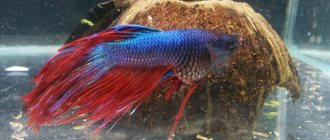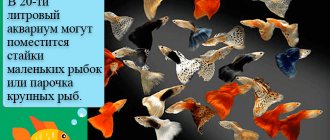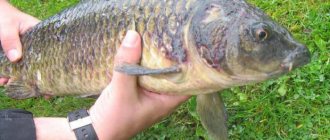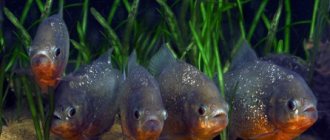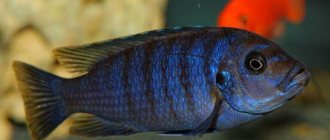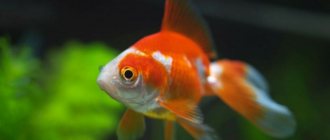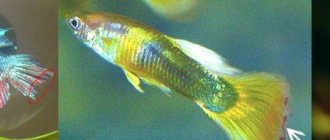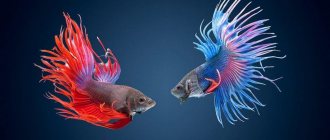Quickly navigate to the article
- 1 Why is this happening? 1.1 Water composition
- 1.2 Biological factor
- 1.3 If the physical parameters of water change
- 2.1 Other interesting articles
Is life in an aquarium as carefree as it seems at first glance? What can disrupt the idyll of the underwater kingdom and make life in it full of problems? Such situations include a picture of fish itching. They rub against the pebbles of the soil, try to lean against the hard parts of the aquarium, become covered with small dotted white rashes, including on the gills, and behave stiffly and tensely.
Ichthyophthiriasis
Symptoms characteristic of ichthyophthyriasis are also characteristic of some other diseases of the same etiology. All of them are treated with the same drug (with the exception of the so-called “imported” ichthyophthyriosis). Externally, the disease is manifested by increased restlessness of the fish, their erratic movement in the aquarium, pressing and trembling of the fins, friction against stones and decorative objects. Some residents may experience shortness of breath and loss of appetite.
The bodies of the fish are gradually covered with a coating of parasites. At first these are just single white dots, but after a while the fish turn out to be completely covered with “semolina”. Ichthyophthiriasis is considered the most common disease in fish.
Fish allergy treatment
Hypersensitivity to fish protein lasts for life. Therefore, any subsequent “food experiment” can end very badly for a person. People with food allergies to fish should completely exclude all types of fish, seafood, caviar, sushi, fish sauces and fish flavorings from their food.
If an allergist has established a food allergy to a certain type of fish, then it will be enough to exclude only it from the food.
Alas, in most cases you have to give up all fish products. How to replace the nutrients contained in fish? If you are not allergic, you can eat eggs, dairy and meat products, vegetable oils, and add iodized salt to salads.
Ichthyophthiriasis “domestic” and “imported”
If the body of the fish is covered with large “semolina”, then we are talking about a “domestic” form of the disease. “Imported” ichthyophthyriosis is characterized by small “semolina” and clusters of lesions of various sizes.
To treat “domestic” ichthyophthyriosis, the drugs Tetra Medica Contralck and Kostapur (Sera costapur) are used. It is easier to cure this form of fish disease than the imported one, for which only SUPER ICK CURE is suitable. They need to carry out the course of treatment in a common aquarium to prevent infection of the remaining inhabitants. It should be used in accordance with the instructions, but if there are scaleless ones in the aquarium, the dose should be reduced by almost half.
Oodinosis, or velvet disease
If you notice that aquarium fish seem to be itching against objects - decorative elements, stones - most likely, we are talking about velvet disease (odinosis). The disease is caused by flagellates, and a similar symptom is characteristic of the initial stage of the disease.
If white spots or dots have already appeared on the body of the fish, and they look as if they were sprinkled with flour, it means that the disease has already advanced. At the same time, the inhabitants of the aquarium acquire a rather pitiful appearance: stuck together fins, a milky coating on the body, shortness of breath. Fish lose their coloring and glossy shine to their skin. Later, the plaque becomes velvety, and the mucous membrane begins to peel off.
The disease is treated with Tetra Medica General Tonic or Sera oodinopur (oodinopur). This is done in a common aquarium so that uninfected fish are treated for preventive purposes.
Chilodonellosis and trichodine
Diseases such as chilodonellosis and trichodine are characterized by similar symptoms, but they are caused by ciliated ciliates. Aquarium fish rub against plants and decorations in the same way, and their fins stick together. The difference is that the skin does not develop a milky coating, but a bluish-white one.
As a rule, only wounded and weakened fish get sick. The ciliate tetrahymena does not affect healthy and strong individuals. The fish's breathing becomes difficult; upon examination, damage to the mucous membrane and gills can be detected.
The disease is treated with Sera costapur, with the addition of Sera ectopur, which increases the amount of oxygen. If there are scaleless fish in the aquarium, the dosage should be halved so as not to burn the skin. In this case, the duration of treatment must be increased.
What you should not do is try to treat fish diseases with antibiotics, such as bicillin. It causes fish to develop intestinal dysbiosis, which can ultimately lead to their death.
Non-infectious
This type includes diseases that appear due to irrational maintenance or the influence of large parasites.
Chlorine poisoning
Caused by exposure to a chemical element.
Symptoms:
- difficulty breathing;
- mucus on gills;
- lightening of the color of the gills;
- restless behavior of pets: they rush around and try to jump out of the container;
- apathy.
At the first manifestations, the pets are immediately transplanted into another container.
Lack of oxygen
The disease occurs in an overcrowded vessel with oxygen deficiency, due to rotting feed residues and dead individuals, at elevated temperatures.
Symptoms:
- restless behavior;
- swimming near the surface;
- gasping for air;
- weakening of the immune system;
- suffocation;
- infertility;
- lack of appetite.
First you need to eliminate the cause of oxygen deficiency, then change some of the water and carry out aeration.
Failure to comply with temperature conditions
The disease is caused by increased or, conversely, decreased temperature of the water in the vessel.
Symptoms of high fever :
- excessively energetic behavior;
- fish rise to the surface due to lack of oxygen.
Symptoms at low temperature :
- lethargy;
- motionless presence at the bottom;
- cold symptoms, often leading to death.
To avoid the occurrence of such diseases, you need to constantly check the water temperature.
Alkali disease
Caused by increased (alkalosis) or decreased (acidosis) pH levels in water.
Symptoms of alkalosis :
- excessive activity;
- spreading of gills and fins;
- lightening of color;
- covering the gills with mucus.
Symptoms of acidosis :
- excessive fearfulness;
- decreased energy;
- fish can swim sideways or belly up.
As a therapeutic measure, you need to gradually change the acid-base balance in the container to normal.
Obesity fish
The reason is an increase in the fat content of food by 3% in herbivorous individuals and 5% in carnivorous individuals. If fish are overfed, provided with a poor or irrational diet, they may also develop signs of obesity. As a result, internal organs are damaged, leading to death.
Symptoms:
- apathy;
- rounding of sides;
- infertility.
To prevent obesity, you need to provide the fish with a varied diet, give them fatty food, and also, for preventive purposes, do not feed them for 2 days. Pets need to swim freely, so you should worry about choosing a container of the appropriate size.
Gas embolism
Appears when the volume of oxygen is exceeded, as a result of which the fish’s blood vessels become clogged and blood supply is disrupted.
Symptoms:
- anxiety;
- sidestroke;
- immobility of gill covers;
- bubbles on individuals.
It is necessary to check air circulation and avoid excess plants, which contribute to the release of increased oxygen and soiling of the soil.
Tumors
As a rule, tumors are caused by physicochemical factors, ionizing radiation, and oncogenic viruses. In some situations, parasites and genetic code become the causes.
Symptoms of melanosarcoma:
- neoplasm;
- black body color.
Other types of tumors can be recognized by their characteristic shape and color. Sometimes they are so large that they swell the pet’s body. Small internal neoplasms are revealed only at autopsy.
Therapeutic measures are powerless. Tumors are quite rare. The affected individual is killed.
Improper feeding
Frequent and abundant feeding of fish, especially monotonous feeding, can cause a number of diseases, including fatal ones. This, as a rule, leads to obesity of internal organs and liver degeneration, as a result of which the fish dies.
Symptoms:
- colorless or bloody thread-like feces;
- hydrocele of the abdomen.
- Dropsy cannot be treated, so the sick fish is removed from the container.
Feeding a monotonous diet poor in vitamins causes vitamin deficiencies, which in turn can lead to metabolic disorders, weakening of the pet’s immune system, and deterioration in its health and appearance.
Therefore, it is necessary to provide your pets with a varied, balanced diet and follow the golden rule of aquarium keeping: “It is better to underfeed than to overfeed.”
Treatment with a complex drug antipar
One of the drugs widely used in the treatment of fish diseases is anti-steam. The active components included in its composition (formalin, malachite green dye) destroy pathogens of fungal infections, helminths, ciliates that affect the mucous membranes, gills, fins and integumentary tissues of fish. In addition, anti-steam promotes the healing of wounds and injuries.
Indications for treatment with anti-steam: saprolegniosis, trichodiniasis, apiozomiasis, ichthyophthyriosis, brooklynellosis, tetrachymeniosis, trichophriasis, dactylogyrosis, chylodonellosis, cryptobiosis, oodiniumosis, cryptokaryosis, heteropolariasis, uronemosis, costiosis, hydrolactylesis of marine and freshwater fish.
The action of the drug is based on the denaturation of proteins by formalin at the cellular level and metabolic disorders in pathogens.
Method of use and dosage of the drug antipar
When it comes to preventing fish diseases, it is recommended to use anti-steam for short baths. Concentration – 1 ml per 10 liters of water, procedure duration – 3 hours. If the fish are already sick, such 3-hour baths should be carried out twice, with an interval of two days. An advanced disease is treated by relocating sick individuals to another aquarium with a medicinal solution (1 ml per 50 liters of water) for 3-8 days (based on the type and severity of the disease).
Before you arrange a short-term bath, you need to catch two or three inhabitants from a dysfunctional aquarium with severe symptoms of the disease and place them in a container with a medicinal solution. If during the first 15 minutes the fish begin to show signs of anxiety, behave unusually, or make sudden movements, it is necessary to treat all fish using the method of long-term baths.
Short-term baths are carried out in a glass vessel with a medicinal solution. After the exposure time has expired, the fish are released into the general aquarium. Before introducing anti-steam preparation into a decorative pool or aquarium, you need to ensure sufficient aeration of the water and turn off the lighting fixtures. The water in the aquarium with the medicinal solution is temporarily not filtered. In this case, there is no need to remove soil and aquatic plants from the aquarium.
During the treatment process, it is necessary to maintain a pH in the aquarium of 5.5-6.8 and a temperature of 24-26 °C. Every 4-5 days you need to add ½ of the therapeutic dose of anti-steam to the solution. At the end of treatment, the solution must be decontaminated, for which it is passed through a carbon filter. Also, after the fish have fully recovered, it is necessary to disinfect all equipment - thermometers, cages, sprayers, scrapers, feeders. To do this, they need to be scalded with boiling water.
Antipar is considered a fairly effective drug for treating fish diseases. But it can harm them if used uncontrollably or treated for the wrong disease. Experts warn that broad-spectrum medications are not effective in 100% of cases. Sometimes it is better to use narrower means. In this case, the correct diagnosis is fundamental.
| Goldfish in your aquarium: main enemies and fish diseases → |
Related publications:
Goldfish in your aquarium: main enemies and diseases of fish Goldfish are the decoration of any aquarium. But only if the owner creates optimal living conditions for them and makes sure that various kinds of pests do not cause damage to them. In particular, goldfish can be threatened by a hydra that has entered a spawning ground, or a dragonfly larva that can destroy thousands of fry in a short period of time. The Cyclops also poses a great danger; avoid unregulated food...
Insidious ciliates. Ichthyophthiriasis of aquarium fish How did the fish get sick if whiteness and small white dots appeared on the fins and scales? So, the fish are infected with ichthyophthyriasis. This disease is caused by the ciliate ichthyophthirius and can be introduced into the aquarium with food from reservoirs, new fish or plants. Ciliates settle between the epithelium and connective tissue of the skin, fins, and gills of fish. It is difficult to determine the disease at first; you can only notice changes in the appearance...
About diseases of aquarium fish Diseases of fish in such a closed water system as an aquarium are directly related to violation of maintenance regimes. To prevent trouble, you must always remember that disease prevention is easier than treatment, that correct diagnosis and quick qualified assistance determine the success of treatment. Therefore, keeping new residents in a quarantine aquarium, observing the correct regime for keeping animals, timely…
Share link:
Invasive
Caused by helminths and arthropods.
Glucose
One of the most dangerous diseases of aquarium fish, caused by sporozoans of the genus Glugea.
Symptoms:
- bulging eyes;
- sidestroke;
- the appearance on the body of whitish bumps filled with blood, developing into ulcers.
There is no cure for glutenosis. After an accurate diagnosis has been established, all fish and plants in the aquarium should be destroyed. The soil, decorations, equipment are boiled, the aquarium is disinfected.
Trichodinosis
The causative agent is the ciliate Trichodina. Appears on the surface of the skin and gills of fish. The disease mainly affects fry, individuals with weak immunity. The outbreak of the disease is caused by non-compliance with the sanitary conditions of the aquarium, overcrowding, and monotonous, meager nutrition.
Symptoms:
- lightish coating on the skin;
- friction against objects;
- restless behavior;
- inflammation of the gills, covering with mucus;
- lack of appetite;
- increased breathing.
Treatment is most effective in the initial stages. Sick individuals are transplanted into a vessel with elevated water temperatures (31-33°C) for a week. The water must be aerated. Medical treatment is carried out using solutions of table or sea salt, methylene blue, trypaflavin, both in a general aquarium and in a quarantine tank.
Ichthyobodosis (Costiosis)
The appearance of the disease is caused by the flagellate Ichthyobodo necator.
Symptoms:
- the appearance of mucus on the skin;
- decreased appetite;
- gradual decomposition of the affected areas;
- the fish itches on various objects;
- in case of damage to the gills - the appearance of mucus, protrusion of the gill cover;
- the appearance of a light blue or light pink coating in places where the parasite accumulates;
- in case of damage to the fins - gluing, destruction of the fin tissue;
- when the form is advanced, ulcers appear;
- labored breathing.
To cure ichthyobodosis, heat the water to 32 °C or place the pets in a separate vessel with a solution of methylene salt.
Parasites
Diseases are caused by worms that have a complex reproductive system. They mainly affect the intestines, but can settle in the gills and muscles.
Symptoms:
- scratching on the bottom;
- excessive appetite, as a result of which the fish does not gain weight or even becomes exhausted;
- bumps may appear under the skin;
- specific fish waste (liquid, with mucus or lumps);
- a reddish “thread” sticks out from the anus;
- if the gills are damaged - inflammation of the gill cover;
- the pet is motionless, it is rocked in the stream of water flowing from the filter;
- dull spots and scuff marks on the leather.
Copper sulfate, Sera Micopur, Sera Ectopur, Fiosept, Antipar are used for therapy. It is advisable to treat pets in an observation aquarium, since parasites are transmitted from sick fish to healthy ones.
Oodiniosis (Velvet disease)
One of the most common diseases caused by a single-celled dinoflagellate algae. It affects all types of freshwater fish, mainly young individuals. It affects the outer integument, gills, and fins.
Symptoms:
- the appearance of small nodules on the surface of the skin and fins, resembling powdery dust from yellow to gray;
- Some fish exhibit anxious behavior, periodically scratching themselves on objects, while others exhibit apathy and inactivity;
- labored breathing;
- intensive mucus secretion;
- the body is covered with a yellow, golden or gray coating;
- flocculent detachment of the skin epithelium, separation of fin rays;
- clumping of fins, destruction of fin tissue.
Secondary infections can also occur, which leads to death. Oodiniosis is treated with UV rays or by adding copper sulfate to water in a separate container (0.15 g/100 l) for a week. Do not add copper-containing preparations to a vessel with invertebrates!
Chylodonellosis
The causative agent is the ciliated ciliate Chilodonella. This is one of the diseases that appears in relatively cold water. Parasitizes the skin and gills. All types of fish are susceptible, with fry being more often affected.
Symptoms:
- clouding of the skin;
- restless behavior;
- refusal of food;
- the body is covered with blue-gray mucus;
- frequent breathing.
When carrying out therapy: in the main vessel, the temperature is increased to 30-32 ° C with simultaneous aeration until the fish begins to feed normally. After the fish gets stronger, you can carry out medicinal treatment in a separate container using potassium permanganate, copper sulfate, malachite green, bicilin-5. When treated in a general aquarium: methylene blue, bicillin-5, malachite green with copper sulfate.
Lerneosis
The disease is caused by the gill crustaceans Lerna. They settle in muscle tissue throughout the body, penetrating the skin. Inflammation develops at the site where the crustacean invades, followed by the formation of ulcers.
Symptoms:
- swaying, slow movement of the fish;
- refusal of food, exhaustion;
- pet rubbing against objects;
- the appearance of ulcers with white edges.
The fish are transplanted into another vessel, and the main one is disinfected. Then the diseased individual is placed in a damp swab and the lerna is carefully removed with tweezers. For disinfection, drug therapy is used in a solution of hydrochloride (0.2 mg/l) for 4 days or table salt (8 g/l) for 14–20 days.
Argulez
The causative agent is the crustacean argulus, which pierces the skin and sucks blood, releasing a toxic liquid. The carp eater violates the integrity of the skin, which leads to infection with various diseases. Crustaceans sit on fish only when they are hungry; the rest of the time they sit on various objects. Fry can die from one bite of an argulus.
Symptoms:
- the appearance of a wound;
- mucous discharge on the body;
- redness;
- edema;
- swaying of the individual and friction against objects.
For therapeutic purposes, pets are sent to another vessel. The fish with the attached carp eater is placed on a damp swab and the crustacean is carefully removed using tweezers. Afterwards it is washed with potassium permanganate.
Ichthyophthiriasis (“Semolina”)
Caused by the ciliate ichthyophthirius. All types of aquarium fish are susceptible. The causative agent of this infection lives in any aquarium, but manifests itself only under unfavorable conditions.
Symptoms:
- tiny bumpy dots all over the body, reminiscent of semolina;
- lack of appetite;
- friction of individuals on the ground;
- frequent stay near the surface of the water due to lack of oxygen;
- excessive timidity, convulsive movement of fins
- in advanced form - loss of scales.
Treatment can be carried out in a common aquarium. A malachite green solution is added to the water (0.9 mg/l for scaly fish, 0.6 mg/l for scaleless fish) daily until symptoms disappear completely. Before each application of the medicine, it is necessary to change 1/4 of the water.
Adding furatsilin (1 tablet per 10 liters of water) will enhance the effect of the malachite green solution. You can also treat with iodine solution (5 drops per 100 liters of water).
We recommend reading the article: Ichthyophthiriasis (semolina) in aquarium fish: treatment in a community aquarium

